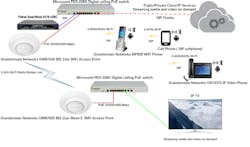Reliable, low-cost Wi-Fi connectivity is the norm -- and an expectation
Fig. A
By BRAD (BIJU) OOMMEN -- Within the networking industry, we are seeing a tremendous growth in Wi-Fi devices and applications. Freedom to compute and communicate wherever and whenever you want is a huge perk, especially when you have reliable Wi-Fi connectivity.
New standards and technologies are ushering in reliable low-cost Wi-Fi connectivity. Now, wireless access points (APs) operate in dual radio bands (2.4GHz / 5GHz) and are embedded with Wi-Fi controller functionality. They support a host of networking standards, protocols and features such as: 802.11ac, 802.11ac Wave 2, 802.11k, 802.11r and 802.11v, Multi-User Multiple Input Multiple Output (MU-MIMO) technology, air time fairness, beamforming, band steering, mesh networking, multiple service set identifiers (SSIDs), PoE/PoE+ on Gigabit Ethernet ports, client bridge function, converting multicast streams to a unicast stream, captive portal for customized branding experiences, centralized cloud Wi-Fi management platform, etc.
Let us take a brief look at how the above features benefit a user’s wireless experience: MU-MIMO enables transmission and reception of multiple data streams simultaneously, using multiple antennas, thus improving overall network throughput. Using the beamforming feature, access points detect the location of clients and direct the antenna beam towards them. Mesh networking features when supported, provide redundancy and create wireless radio connections between APs. Embedded Wi-Fi controller functionality in the AP is not only cost-effective, but also permits centralized management and set-up of other APs, and clients, across the wireless network. Band steering enables APs to select the least used radio band. Multiple SSIDs permit multiple wireless segments. Client bridge functionality allows an AP operating in that mode to bridge the wired clients. When the AP converts multicast to unicast streams over the wireless link, it improves the quality and reliability of video and audio streams while preserving bandwidth for other wireless clients. For a customized branding experience, we can even use a customized splash page or captive page (a web page that is displayed to newly connected Wi-Fi users prompting for authentication etc.). A centralized cloud Wi-Fi management platform can enable control and management that spans across unlimited APs and geographic locations, all without any hardware controllers located on premises.
What does Multi-User (MU) mean when discussing 802.11ax?
For this ongoing discussion and functional testing, let us consider Grandstream Networks’ Wi-Fi access points GWN7600, GWN7610 (Please refer to Fig. A) [which have embedded controllers] and the associated cloud controller GWN.cloud. The following links include the product specs:
Grandstream Networks GWN7600 802.11ac Wave-2 Wi-Fi access point
Grandstream Networks GWN7610 802.11ac Wi-Fi Access Point
Grandstream Networks Cloud Controller for Grandstream’s GWN series
The GWN7600 802.11ac Wave-2 dual band access point's key features are as follows:
•Offers 1.27 Gbps wireless throughput • The embedded controller in the unit can auto-discover /auto-provision/manage 30 other GWN76xx APs without a separate controller •2 autosensing 1Gbps Ethernet ports •Allows 16 SSIDs • Offers support for up 450 concurrent clients in a 165 m range •3 tri-color LEDs provide device tracking and status indication •Supports Power over Ethernet (PoE) •Channel bandwidth offered in- 2.4 GHz band is 20 MHz and 40 MHz- 5 GHz- 20 MHz, 40 MHz and 80MHz •QoS for low latency and real time applications •3 tri-color LEDs provide device tracking and status indication •Internal 3dBi gain antennas-2 x 2.4 GHz/2 x 5 GHz , for MIMO it offers 2x2:2 2.4GHz, 2x2:2 5 GHz (MU-MIMO)
The GWN7610 802.11ac dual band access point's key features include:
•Offers 1.75 Gbps wireless throughput • The embedded controller in the unit can auto-discover /auto-provision/manage 50 other GWN76xx APs without a separate controller •2 autosensing 1Gbps Ethernet ports •Allows 16 SSIDs • Offers support for up 250 concurrent clients in a 175 m range •Supports Power over Ethernet •Channel bandwidth offered in- 2.4 GHz band is 20 MHz and 40 MHz- 5 GHz- 20 MHz, 40 MHz and 80MHz •QoS for low latency and real time applications • Internal 3dBi gain antennas-3 x 2.4 GHz/3 x 5 GHz , for MIMO it offers 3x3:3 2.4GHz, 3x3:3 5GHz •3 tri-color LEDs provide device tracking and status indication
Grandstream Networks’ GWN.cloud is the enterprise cloud controller Wi-Fi management platform, whose benefits include the following:
•Hosted on Amazon web services (AWS) •Network management- monitoring, maintenance and reporting on unlimited APs and sites •Access via web and or mobile app with TLS encryption end to end and X.509 certificate-based authentication •Mobile app for ioS and android •Real-time status/alerts and report information on the APs and clients and 30 days archival of historical data •Offers access policy configuration for blacklisting, whitelisting, time schedule based access and bandwidth rules for client access •Security modes such as WPA, WPA2 etc.
We created a mock-deployment to functionally test the GWN7600, GWN7610 and the GWN.cloud. We checked the embedded controller function on GWN7600 and GWN7610. The GWN7610 was also setup in client bridge mode. On the test Wi-Fi network, we ran real time voice, video calls and real time streaming media and video traffic.
FUNCTIONAL TESTING
Grandstream Networks’ GWN7600 and GWN7610 running the main software release version:1.0.8.18 along with the following systems and subsystems (Please refer to Fig. B) were used for the testing:
•Public SIP trunk services
•Grandstream Networks GXV3370 IP video phone main software release version:1.0.1.33
•Patton SmartNode SN5570 Series eSBC (Enterprise Session Border Controller) running software version Trinity 3.15.1-19021 will provide SIP demarcation from the public SIP trunk provider while maintaining interoperability and inter-connectivity.
•Grandstream Networks WP820 Wi-Fi phone main software release version:1.0.3.6
•Microsemi PDS-208G Digital Ceiling PoE switch running main software release version: 2.53
The GWN7600 and GWN7610 were powered up using PoE offered by the Microsemi PDS-208G Digital Ceiling PoE switch. They both have an embedded Wi-Fi controller and hence at different times we were able to set one of them as the master/controller over the other. Before we started, we used the Patton Cloud (the eSBC was already provisioned on it), which is a single portal network orchestration tool in the cloud to upgrade the software on our CPE device namely the Patton SmartNode SN5570 eSBC to Trinity 3.15.1-19021. We then logged into the GWN7600 using a browser. Thanks to the easy to use web GUI, we navigated to SSID and clicked on it to manage the SSIDs. We edited the existing SSID: enabled it, put in a SSID name, selected SSID dual band, selected appropriate values for the security mode, WPA key mode, WPA encryption type and the WPA pre-shared key.
After that, we chose multicast to unicast, so that the AP converts multicast streams to unicast streams over the wireless link, enabled enterprise voice, then saved and applied the changes we made. Next, we navigated to the item listed as access points in the menu and edited the configuration of GWN7600. We gave the device a name, selected fixed IP (set the values for IPv4 Address, IPv4 Subnet Mask, IPv4 Gateway, Preferred IPv4 DNS etc.) and put a check mark on airtime fairness. We set band steering as balanced, so that the AP can lead the client based on spectrum utilization of the two radio bands. Under 2.4 Ghz we set the channel width to 20/40 MHz and selected Allow Legacy Devices(802.11b). We put a check mark against dynamic channel assignment, transmit power Control and coverage hole detection for both 2.4 Ghz and 5 Ghz bands. We then turned our attention to the GWN7600. We followed the configuration steps as listed above but with different values for some of the settings (SSID, IP address etc.).
Fig. B: Functional testing of Grandstream Networks’ GWN7600/GWN7610 APs
Now both GWN7600 and GWN7610 were deployed as APs. Using a Wi-Fi scanner, we undertook a Wi-Fi scan to check our test SSID 7600 as shown in Fig.C
We proceeded to configure the GWN 7610 as an online bridge. Please refer Fig.D
Fig. D: GWN7600 status as Master/controller & GWN7610 as online bridge
We clicked on overview shown in Fig. E, it gave us a top-level summary view with lots of useful information on our Wi-Fi network such as AP, clients, AP channel distribution, top AP, top SSID, top clients, alerts/notifications. For each of those items we could drill down further for more granular controls and details.
Fig. E: GWN7600 master/controller overview screen
Clicking on clients Fig. F brings up useful network data and performance metrics of clients. You can also, with a single click, view granular status/stats and block or release a client. All the presented performance and operational data helped immensely with our capacity planning, aided in trouble shooting and optimization of the Wi-Fi network.
Fig. F: GWN7600 Master/Controller clients screen
We were able to use the above deployed Wi-Fi network to register the Grandstream Networks GXV3370 IP video phone, and Grandstream Networks WP820 Wi-Fi handset with the ITSP provided external SIP trunk through the Patton SmartNode SN5570 eSBC. All inbound/outbound test calls worked as expected. We also had a smart phone running a SIP client, VoIP over Wi-Fi that connected and registered with the Unified Communications as a Service (UCaaS) platform in the cloud. Our functional testing was successful based on our ability to run applications with a demand for high bandwidth and low latency such as real time voice, video calls and video streaming traffic over the Wi-Fi network.
Best practices for deploying 802.11ax WiFi APs with Cat 6a cabling
We turned off the client bridge feature and turned on the captive portal with an associated policy for a customized branding experience. For the newly connected Wi-Fi user our designated web page successfully prompted for authentication, accept terms of use etc. A noteworthy aspect are the 3 tri-color LEDs provide device tracking (click on locate the device and they start blinking white) and status indication.
Let us now transfer the APs to GWN.cloud which is the enterprise cloud controller Wi-Fi management platform. As we could access the GWN cloud from anywhere, we could now manage our GWN7600 and GWN7610 APs and clients from anywhere by just using a browser. GWN cloud is indeed a true centralized enterprise cloud controller Wi-Fi management platform that provided us with real-time data, status/alerts and report information on the clients and APs. We can refer to Fig. G for the GWN cloud screen.
Fig. G: GWN.cloud dashboard and access points Summary screens.
Deploying and administering the GWN7600 and GWN7610 was very easy due to the embedded Wi-Fi controller functionality.
Conclusion
If your digital transformation strategy includes a need for a low-cost and reliable Wi-Fi network, our functional testing of Grandstream's GWN series of Wi-Fi access points, and GWN.cloud enterprise cloud controller, amply demonstrate that they are capable of this. You can deliver a cost-effective, scalable, agile and secure wireless service that spans across unlimited APs and geographic locations without hardware controllers on premise. If lower total cost of ownership (TCO) of your Wi-Fi infrastructure is one of your goals, then you would want to check Grandstream Networks’ above-mentioned Wi-Fi offerings.
About the Author
Brad (Biju) Oommen is a network architect and principal consultant. His work revolves around multi-vendor products and technology integration. It spans the domains of Unified Communications, Omni-channel Contact Center, VoIP-SIP, SDH, EoS, Wi-Fi/VoWiFi, SSL VPN, application acceleration, email and network security, SDN, SEM, SAN, IP networks, Fiber and Microwave communications. He can be contacted at [email protected] or [email protected]








